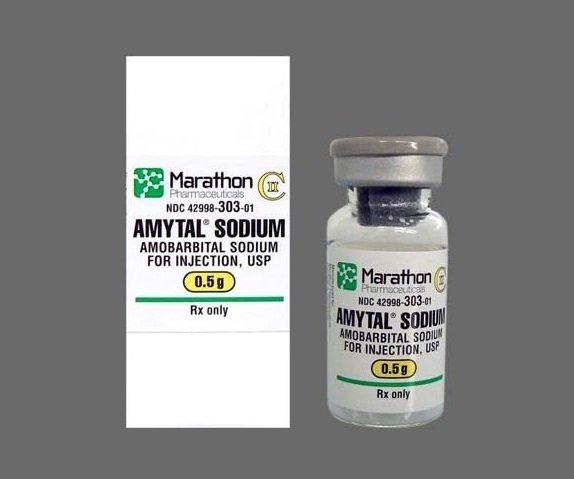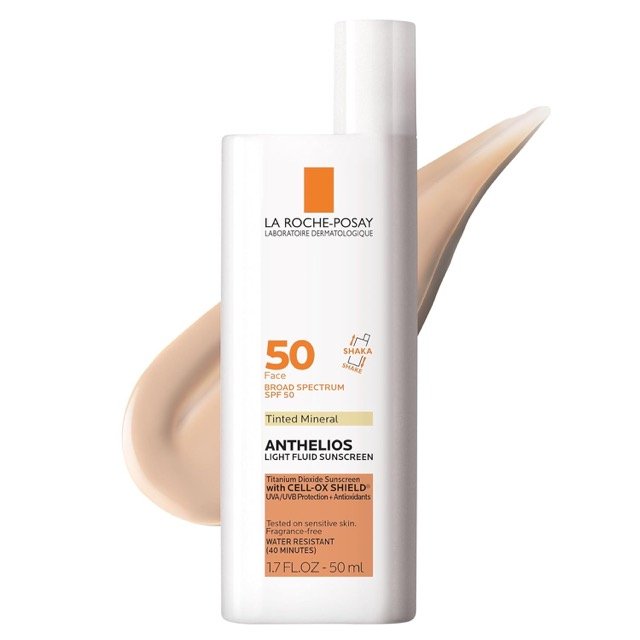Amobarbital is a barbiturate medication primarily used as a sedative-hypnotic agent. It belongs to the class of drugs known as barbiturates, which act on the central nervous system to produce a calming effect. Amobarbital is commonly prescribed for short-term treatment of insomnia, anxiety, and certain types of seizures. It works by enhancing the activity of the neurotransmitter gamma-aminobutyric acid (GABA), which inhibits brain activity, leading to sedation and relaxation.
Amobarbital is an intermediate-acting barbiturate that causes sleepiness, drowsiness, and hypnosis by suppressing the sensory cortex, reducing motor activity, and altering cerebellar function.
It is used as a sedative, hypnotic, or as a pre-anaesthetic.
It is also used as an off-label treatment for diagnostic and therapeutic purposes in amytal interviewing (Wada test) for psychiatric purposes.
Amobarbital Dose in Adult
Amobarbital Dose for use as a Hypnotic:
- Through a muscle injection (IM) or through a vein injection (IV).
- The dose usually ranges from 65 to 200 milligrams, and it's taken at bedtime.
- The most someone might get in one dose is 1,000 milligrams, but that's the highest limit.
Amobarbital Use as a Sedative:
- It's given through muscle (IM) or vein (IV) injections.
- The typical dose ranges from 30 to 50 milligrams, and it's usually given two or three times a day.
- But, the most someone might get in one dose is 1,000 milligrams, that's the highest limit for safety.
Amobarbital off-label use in the “Amytal interview”:
- They typically give it through a vein (IV) at a rate of 50 to 100 milligrams per minute.
- They keep giving it until the person feels drowsy or shows signs like having trouble paying attention, speaking clearly, or their eyes moving involuntarily (nystagmus).
- The total dose can range from 200 to 1,000 milligrams, depending on how the person reacts.
Amobarbital off Label use in the Wada test:
- It's given directly into the carotid artery (intra-carotid).
- This is done through a thin tube inserted through the groin (percutaneous transfemoral catheter).
- The dose typically ranges from 60 to 200 milligrams, with the usual amount being 125 milligrams.
- It's injected over a very short time, usually 2 to 5 seconds.
- After waiting for about 30 to 45 minutes, another dose may be given to test the other side of the brain.
Note: However, because of the side effects linked to this method and doubts about its reliability and accuracy, other less invasive tests like functional MRI might be suggested instead.
Amobarbital Dose in Children
Amobarbital use in Hypnotic as in preoperative sedation:
For children aged 6 years and older, including adolescents:
- It's typically given through a muscle injection (IM), which is preferred, or through a vein (IV).
- The usual recommendation is 2 to 3 milligrams per kilogram of body weight per dose, with the maximum dose being 500 milligrams per dose.
- However, there's limited data available for this age group, so dosing is often based on expert recommendations rather than specific trial data.
- The manufacturer suggests a dose range of 65 to 500 milligrams for children aged 6 to 12 years, but dosing based on patient size isn't provided.
- It's recommended to start at the lower end of the range and adjust the dose as needed.
Amobarbital use in Intracarotid amobarbital procedure (Wada test):
For children aged 6 years and older, including adolescents:
- There's limited data available for dosing.
- Typical dosing ranges from 75 to 125 milligrams per dose.
- This medication is usually given directly into the artery through a catheter inserted in the groin area (femoral arterial catheter).
Pregnancy Risk Factor D
- When it comes to pregnancy, barbiturates like amobarbital pose a risk factor D, which means they can cross the placenta and reach the baby's tissues.
- If a pregnant person takes barbiturates, especially during the first trimester, it can increase the risk of birth defects in the baby.
- Additionally, if exposure occurs during the third trimester, the baby may experience symptoms of withdrawal after birth, which can appear immediately or be delayed for up to 14 days.
Amobarbital during breastfeeding:
- Barbiturates, including amobarbital, can be found in small amounts in breast milk.
- However, specific information regarding amobarbital's presence in breast milk isn't available.
- Because of this, it's essential to use caution if amobarbital is given to a breastfeeding woman.
Amobarbital Dose in Renal Disease:
- The manufacturer's labeling for amobarbital doesn't include specific dosage adjustments for people with renal impairment.
Amobarbital Dose in Liver Disease:
- In the manufacturer's labeling for amobarbital, there are no specific dosage adjustments provided for individuals with hepatic impairment.
Amobarbital side effects:
- Respiratory:
- Atelectasis
- Apnea
- Hypoventilation
- Cardiovascular:
- Bradycardia
- Hypotension
- Syncope
- Gastrointestinal:
- Constipation
- Nausea
- Vomiting
- Central Nervous System:
- Ataxia
- Nervousness
- Nightmares
- Psychiatric Disturbance
- Central Nervous System Depression
- Confusion
- Abnormality In Thinking
- Agitation
- Headache
- Insomnia
- Anxiety
- Dizziness
- Drowsiness
- Hallucination
- Miscellaneous:
- Fever
- Hematologic & Oncologic:
- Megaloblastic Anemia with chronic use
- Hepatic:
- Hepatic Injury
- Neuromuscular & Skeletal:
- Hyperkinesia
- Hypersensitivity:
- Hypersensitivity Reaction
- Angioedema
- Exfoliative Dermatitis
- Skin Rash
- Hypersensitivity Reaction
- Local:
- Injection Site Reaction
Contraindications to Amobarbital Include:
- If someone has had a bad reaction to barbiturates or any part of the medicine before, they shouldn't take it.
- Also, if they have a history of a certain blood disorder called porphyria, it's not safe for them to use it.
- People with severe liver problems or serious breathing issues where it's hard to breathe or there's a blockage should also avoid it.
- These conditions could make the medicine harmful or less effective, so it's best to steer clear of it in those situations.
Warnings and Precautions
CNS depression:
- Taking amobarbital can slow down the central nervous system, which might affect a person's ability to think clearly or react quickly.
- Because of this, it's important to warn patients about doing activities that need them to be mentally sharp, like driving or operating machinery.
- They should be cautious and consider how the medicine might affect their ability to do these tasks safely.
Paradoxical responses:
- Amobarbital might cause an unexpected reaction in some people, where instead of feeling calm, they become more excited or agitated.
- This is more likely to happen in individuals who have acute or chronic pain.
Depression
- If someone has depression or feelings of wanting to harm themselves, it's important to be careful when considering the use of amobarbital.
Use of drugs:
- Amobarbital should be approached with caution, or possibly avoided altogether, in individuals with a history of drug abuse or acute alcoholism.
- There's a risk of developing dependency on the medication, both psychologically and physically, especially with long-term use.
- Tolerance, where the medication becomes less effective over time, can also happen.
Hepatic impairment
- If someone has liver problems, it's important to be cautious when using amobarbital.
- They might need a lower dose than usual.
- In severe cases, where the liver isn't working well, using amobarbital is not recommended.
- Also, it shouldn't be given to people who show early signs of liver failure.
- It's crucial to monitor liver function and adjust the treatment plan accordingly to ensure safety.
Hypoadrenalism
- If someone has borderline hypoadrenal function, meaning their adrenal glands aren't working quite as they should, it's important to be cautious when using amobarbital.
- This caution applies whether the issue is with the pituitary gland or the adrenal glands themselves.
- Amobarbital can affect how corticosteroids, which are hormones produced by the adrenal glands, work in the body, both those made naturally and those taken as medication.
- So, it's essential to monitor closely and adjust treatment as needed to maintain proper adrenal function.
Renal impairment
- If someone has kidney problems, it's important to be cautious when using amobarbital.
- They might need a lower dose than usual.
- Monitoring kidney function and adjusting the dose accordingly can help ensure the medication is used safely and effectively in individuals with renal impairment.
Respiratory disease
- When someone has a respiratory disease, like asthma or chronic obstructive pulmonary disease (COPD), it's important to be cautious when using amobarbital.
Amobarbital: Drug Interaction
Note: Drug Interaction Categories:
- Risk Factor C: Monitor When Using Combination
- Risk Factor D: Consider Treatment Modification
- Risk Factor X: Avoid Concomitant Use
|
Risk Factor C (Monitor therapy). |
|
|
Alcohol (Ethyl) |
CNS Depressants can increase the CNS depressant effects of Alcohol (Ethyl). |
|
Alizapride |
CNS Depressants may increase the CNS depressant effects. |
|
Beta-Blockers |
Beta-Blockers may be decreased by barbiturates. Exceptions: Atenolol; Levobunolol; Metipranolol; Nadolol. |
|
Blood Pressure Lowering Agents |
The hypotensive effects of Blood Pressure Lowering Agents may be enhanced by barbiturates. |
|
Brexanolone |
CNS Depressants can increase the CNS depressant effects of Brexanolone. |
|
Brimonidine (Topical) |
CNS Depressants may increase the CNS depressant effects. |
|
Bromopride |
CNS Depressants may increase the CNS depressant effects. |
|
Calcium Channel Blockers |
Barbiturates could make calcium channel blockers more metabolisable. Management: When utilising concurrent barbiturate therapy, keep an eye out for any reduction in the therapeutic benefits of calcium channel blockers. It could be necessary to change the dose of calcium channel blockers. Phenobarbital and nimodipine cannot be used together, according to Canadian labelling. The exception is clevidipine. |
|
Cannabidiol |
CNS Depressants may intensify the effects of CNS Depressants. |
|
Cannabis |
CNS Depressants may intensify the effects of CNS Depressants. |
|
Chlorphenesin Carbamate |
They may have a harmful/toxic impact that can be made worse by CNS Depressants. |
|
CNS Depressants |
Can increase the toxic/adverse effects of CNS Depressants. |
|
Dimethindene (Topical). |
CNS Depressants may increase the CNS depressant effects. |
|
Doxylamine |
The brain may be more significantly depressed by CNS Depressants. Management: The producer of the pregnancy-safe drug Diclegis (doxylamine/pyridoxine) particularly advises against combining it with other CNS depressants. |
|
CNS Depressants may intensify the effects of CNS Depressants. |
|
|
CNS Depressants may intensify the effects of CNS Depressants. |
|
|
might raise serum barbiturates levels. Barbiturates may lower the serum levels of felbamate. Management: If felbamate is started or the dose is raised, keep an eye out for increasing barbiturate concentrations and toxicity or lowered concentrations and effects. Refer to the dose instructions for patients receiving phenobarbital. |
|
|
Griseofulvin serum concentration may be decreased by barbiturates |
|
|
Kava Kava |
CNS Depressants may have an adverse/toxic effect that can be exacerbated by them. |
|
CNS Depressants may have a greater depressant effect on the brain. Management: Separate drug interaction monographs are available for drugs listed as an exception to this monograph. |
|
|
Magnesium Sulfate |
CNS Depressants may increase the CNS depressant effects. |
|
MetyroSINE may have a sedative effect that can be enhanced by CNS depressants. |
|
|
Minocycline |
CNS Depressants may increase the CNS depressant effects. |
|
Mirtazapine |
CNS Depressants can increase the CNS depressant effects of Mirtazapine. |
|
Multivitamins/Minerals (with ADEK, Folate, Iron) |
might reduce the level of barbiturates in the serum. |
|
Nabilone |
CNS Depressants may increase the CNS depressant effects. |
|
Piribedil |
CNS Depressants could increase the CNS depressant effects of Piribedil. |
|
Pramipexole |
Pramipexole may have a greater sedative effect if it is combined with CNS depressants. |
|
Can increase the toxic/adverse effects of Barbiturates. Primidone can be converted to Phenobarbital and is therefore added to existing barbiturate therapies. |
|
|
Propacetamol |
Barbiturates have the potential to promote propacetamol metabolism. Both the likelihood of liver damage and the desirable benefits of propacetamol may be decreased as a result of this. |
|
Barbiturates' metabolism might be accelerated. It could become more obvious with high pyridoxine doses (such as 200 mg/day). |
|
|
Rifamycin Derivatives |
May increase the metabolism of Barbiturates. |
|
ROPINIRole |
CNS Depressants can increase the sedative effects of ROPINIRole. |
|
Rotigotine |
CNS Depressants can increase the sedative effects of Rotigotine. |
|
Rufinamide |
CNS Depressants may have an adverse/toxic effect that can be exacerbated by this. Particularly, dizziness and sleepiness may be increased. |
|
Selective Serotonin Reuptake inhibitors |
CNS Depressants can increase the toxic/adverse effects of Selective Serotonin Reuptake Inhibitors. Particularly, psychomotor impairment could be increased. |
|
Tetrahydrocannabinol |
CNS Depressants may increase the CNS depressant effects. |
|
Tetrahydrocannabinol, and Cannabidiol |
CNS Depressants may increase the CNS depressant effects. |
|
Theophylline Derivatives |
The serum concentrations of Theophylline Derivatives may be decreased by barbiturates. Dyphylline is an exception. |
|
Thiazide and Thiazide -Like Diuretics |
Barbiturates may increase the orthostatic hypotensive effects of Thiazide-Like Diuretics and Thiazide-Like Thiazide. |
|
CNS Depressants may increase the CNS depressant effects. |
|
|
Valproate Products |
Could increase the serum level of Barbiturates. The serum concentration of Valproate Products may be decreased by Barbiturates. |
|
Risk Factor D (Consider therapy modifications) |
|
|
Blonanserin |
CNS Depressants can increase the CNS depressant effects of Blonanserin. |
|
CNS Depressants can increase the CNS depressant effects of buprenorphine. Management: Consider reduced doses of other CNS depressants, and avoiding such drugs in patients at high risk of buprenorphine overuse/self-injection. Buprenorphine patches (Butrans) should be initiated at 5 mg/hr for adults when taken with other CNS depression drugs. |
|
|
Chloramphenicol (Systemic) |
Barbiturates may slow down metabolism. The metabolism of Chloramphenicol (Systemic) may be increased by Barbiturates |
|
Chlormethiazole |
CNS Depressants may increase the CNS depressant effects. Monitoring: Look out for signs of CNS depression. If a combination of chlormethiazole and other drugs is required, a reduced dose should be used. |
|
CycloSPORINE Systemic |
CycloSPORINE (Systemic) metabolism may be increased by barbiturates |
|
Doxycycline may be reduced by barbiturates. |
|
|
CNS Depressants may increase the CNS depressant effects. Management: Droperidol and other CNS agents, such as opioids, may be reduced or used in combination with droperidol. Separate drug interaction monographs provide more detail on exceptions to this monograph. |
|
|
Estrogen Derivatives (Contraceptive) |
The therapeutic benefits of oestrogen derivatives may be diminished by barbiturates (Contraceptives). It is possible for a method of contraception to fail. Treatment: Using nonhormonal contraception is advised. |
|
Flunitrazepam |
CNS Depressants can increase the CNS depressant effects of Flunitrazepam. |
|
HYDROcodone |
CNS Depressants can increase the CNS depressant effects of HYDROcodone. When possible, avoid concomitant use with hydrocodone and other CNS depressants. Combining these agents is not recommended unless there are other options. Limit the amount and duration of each drug when combined. |
|
Barbiturates may increase the CNS depressant effects. Management: If a barbiturate is used in combination with hydroxyzine, you may consider a reduction of the dose. Patients should be closely monitored for excessive response to concurrent use. |
|
|
LamoTRIgine |
Barbiturates may lower the amount of LamoTRIgine in the serum. Management: For age-dependent recommendations on using a barbiturate concurrently with lamotrigine, see the prescription information. If the barbiturate is withdrawn, change the dosage of the lamotrigine as well. |
|
Methotrimeprazine may have a higher CNS depressant activity than CNS Depressants. Methotrimeprazine can increase the CNS depressant effects of CNS Depressants. Management: Lower the adult dose of CNS Depressants by 50% and start concomitant methotrimeprazine treatment. After the clinically proven efficacy of methotrimeprazine, further CNS depressant dosage adjustments should only be made. |
|
|
Opioid Agonists |
CNS Depressants can increase the CNS depressant effects of Opioid Agonists. Management: When possible, avoid concomitant use of opioid agonists and other CNS depressants. Combining these agents is not recommended unless there are other options. Limit the amount and duration of each drug when combined. |
|
CNS Depressants can increase OxyCODONE's CNS depressant effects. When possible, avoid the simultaneous use of oxycodone and other CNS depressants. Combining these agents is not recommended unless there are other options. Limit the amount and duration of each drug when combined. |
|
|
CNS Depressants may have a greater CNS depressant effect. Perampanel and any other CNS depressant drug should be used in combination. Patients who take perampanel together with any other drug with CNS depressant activity should not engage in complex or high-risk activities until they have had experience with the combination. |
|
|
Contraceptive Progestins |
Progestin's therapeutic effects may be diminished by barbiturates (Contraceptives). It is possible to have contraceptive failure. Management: It is recommended to use nonhormonal contraceptives. |
|
CNS Depressants may have a greater depressant effect if taken in combination. Management: Look for alternatives to the combination use. If you must combine use, reduce the dose of any one or more drugs. It is not recommended to combine sodium oxybate and alcohol, or any sedative-hypnotics. |
|
|
CNS Depressants can increase the CNS depressant effects of Suvorexant. Management: Suvorexant or any other CNS depression can be reduced in doses. Suvorexant should not be taken with alcohol. It is also not recommended to take suvorexant along with any other drugs for insomnia. |
|
|
Tapentadol |
CNS Depressants may increase the CNS depressant effects. Tapentadol, benzodiazepines and other CNS depressants should be avoided when possible. Combining these agents is not recommended unless there are other options. Limit the amount and duration of each drug when combined. |
|
Teniposide serum concentrations may be decreased by barbiturates. Management: There is a possibility of a decreased teniposide level if you combine barbiturates with teniposide. Monitor the teniposide response carefully if you cannot avoid the combination. |
|
|
Tricyclic Antidepressants |
Tricyclic Antidepressants may be more metabolically active if they are taken with barbiturates. |
|
Vitamin K antagonists (eg warfarin) |
Vitamin K Antagonist metabolism may be increased by barbiturates. Monitoring INR closely is important. After a barbiturate has been initiated or administered at a higher dose, an increase in anticoagulant dosage may be necessary. Following discontinuation of barbiturate or reduction in dose, an anticoagulant dose drop may be necessary. |
|
Zolpidem |
CNS Depressants can increase the CNS depressant effects of Zolpidem. Management: For men who also take CNS depressants, reduce the adult Intermezzo brand sublingual Zolpidem dose to 1.75mg. For women, no dose adjustment is advised. Avoid using CNS depressants at night; do not use alcohol. |
|
Risk Factor X (Avoid Combination) |
|
|
Azelastine (Nasal) |
CNS Depressants could increase the CNS depressant effects of Azelastine. |
|
Bromperidol |
CNS Depressants may increase the CNS depressant effects. |
|
Hemin |
Hemin's therapeutic effects may be diminished by barbiturates. |
|
Methoxyflurane |
Methoxyflurane's nephrotoxic effects may be enhanced by barbiturates. Methoxyflurane metabolism may be increased by barbiturates |
|
Mianserin |
Barbiturates may increase the CNS depressant effects. Barbiturates' therapeutic effects may be diminished by Mianserin. Mianserin serum concentration may be decreased by Barbiturates. |
|
Orphenadrine |
Orphenadrine may be more effective against CNS depression than other drugs. |
|
Oxomemazine |
CNS Depressants may increase the CNS depressant effects. |
|
Paraldehyde |
Paraldehyde may be enhanced by CNS depressants. |
|
Somatostatin Acetate |
Possibly makes barbiturates more poisonous or harmful. Somatostatin Acetate in particular has the potential to intensify or extend the sedative effects of barbiturates. |
|
Thalidomide |
CNS Depressants can increase Thalidomide's CNS depressant effects. |
|
Ulipristal |
The serum concentration of Ulipristal may be decreased by barbiturates. |
|
Voriconazole |
The serum concentration of Voriconazole may be decreased by barbiturates. |
Monitor:
Monitoring during IV Administration:
- Keep an eye on vital signs like heart rate, blood pressure, and breathing, especially when giving amobarbital through a vein (IV).
- Monitor cardiac function to ensure the heart is working properly during IV administration.
Renal Function:
- Regularly check how well the kidneys are working, especially if someone is using amobarbital for a long time.
- Adjust the dosage if needed based on kidney function to prevent any problems.
Hepatic Function:
- Keep an eye on liver function, especially with prolonged therapy using amobarbital.
- Adjust the dosage as necessary in people with liver issues to ensure safety and effectiveness of the medication.
How to administer Amobarbital?
Intramuscular (IM) Administration:
- Inject deeply into a large muscle.
- Avoid using more than 5 mL of amobarbital (regardless of concentration) at any single site to prevent tissue damage.
- Consider using a 20% solution for larger doses, as it facilitates administration.
Intravenous (IV) Administration:
- Reserve IV use for situations where IM administration isn't possible.
- Administer slowly via IV injection, with a maximum infusion rate of 50 mg/minute in adults.
- In specific cases, such as during an "Amytal interview," the rate may be increased to up to 100 mg/minute.
Intra-carotid Administration (Off-label for Wada Test):
- During the Wada test, administer the dose over 2 to 5 seconds through a percutaneous transfemoral catheter into the internal carotid artery.
Mechanism of action of Amobarbital:
- Amobarbital is an intermediate-acting barbiturate.
- Barbiturates like amobarbital work by calming down the sensory cortex, which is the part of the brain involved in processing sensations.
- They also reduce motor activity and change how the cerebellum, which controls movement and coordination, functions.
- This leads to feelings of drowsiness, sedation, and hypnosis, which can help with conditions like insomnia or anxiety.
Onset of Action:
- Amobarbital's effects kick in quickly, typically within minutes after administration.
Duration of Action:
- The duration of amobarbital's effects can vary from person to person.
Metabolism:
- The liver primarily breaks down amobarbital using microsomal enzymes.
Half-life Elimination:
- Amobarbital stays in the body for a while, with a half-life ranging from 16 to 40 hours (average of 25 hours).
Time to Peak:
- It takes several hours to reach maximum effect after taking amobarbital.
Excretion:
- The body eliminates amobarbital and its byproducts mostly through urine, with only small amounts excreted unchanged. Some metabolites may also be expelled through feces.
International Brands of Amobarbital:
- Amital
- Amybital
- Amycal
- Amytal
- Amytal Sodium
- Barbamyl
- Eunoctal
- Isomytal
- Neur-Amyl
- Sodium Amytal
Amobarbital Brands in Pakistan:
No brands available in Pakistan.









